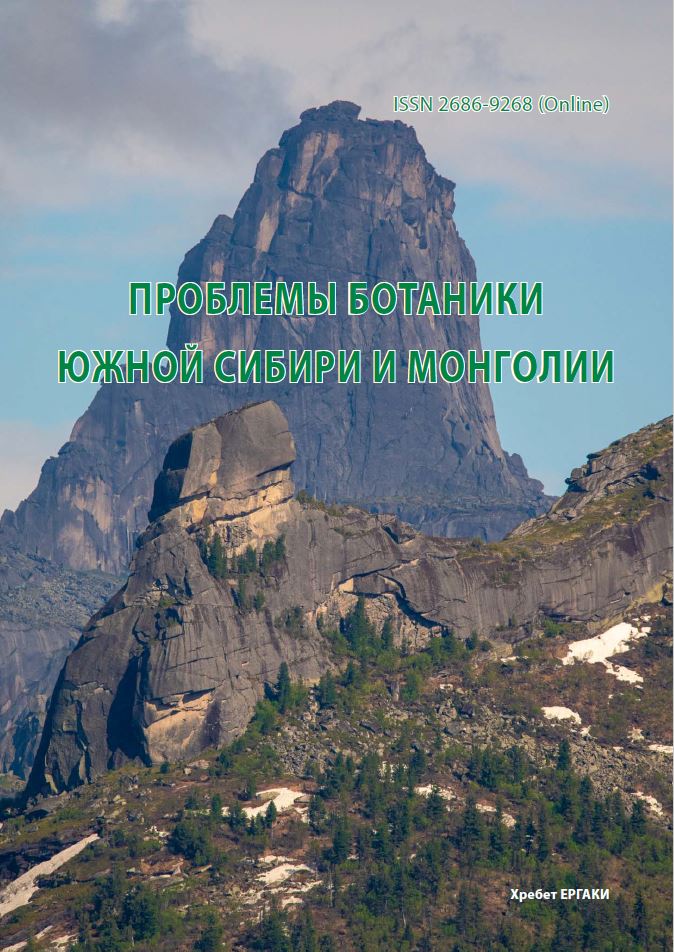The elemental composition of Nostoc commune (Cyanoprokaryota) from the Baikal region
УДК 582.232.5:581.192(571.53)
Abstract
We have established concentrations of 32 elements (Ag, Al, As, Ba, Be, Bi, Ca, Cd, Ce, Co, Cr, Cu, Fe, K, La, Li, Mg, Mn, Mo, Na, Ni, P, Pb, S, Sb, Sc, Sr, Ti, V, W, Y, Zn) in the thalloms of the terrestrial algae Nostoc commune from the Baikal region, functioning in the meadow steppe on sod-carbonate soil. Nostoc commune is a widespread species in terrestrial ecosystems, capable of oxygenic photosynthesis and fixation of atmospheric nitrogen. The concentrations of elements in the Nostoc commune from the Baikal region according to the degree of reduction are presented in the following series: Al > Ca > Mg > K > Fe > P > S > Ti > Na > Ba > Sr > Mn > Cr > Zn > V > Li > Ni > Ce > Cu > La > Bi > Sb > W >Y > Pb > Sc > Co > As > Mo > Ag > Be > Cd. High correlations between the content of Ca, Mg, K in the soil and thalloms of the species were revealed.
Downloads
Metrics
References
Болышев Н. Н. Водоросли и их роль в образовании почв. - М.: Изд-во Моск. ун-та, 1968. - 84 с.
Егорова И. Н., Шергина О. В, Тупикова Г. С. Минеральный состав почвенной цианопрокариоты Nostoc commune из Байкальского региона // Известия вузов. Прикладная химия и биотехнология, 2023. - № 1. - С. 67-76.
Еленкин А. А. О некоторых съедобных пресноводных водорослях // Природа, 1931. - № 10. - С. 695-992.
Куликова Н. Н., Парадина Л. Ф., Сутурин А. Н., Таничева И. В., Ижболдина Л. А., Ханаев И. В., Тимошкин О. А. Микроэлементный состав круглогодично вегетирующих макроводорослей каменистой литорали оз. Байкал (Россия) // Альгология, 2008. - Т. 18, № 3. - С. 244-255.
Потанин Г. Н. Тангутско-Тибетская окраина Китая и Центральная Монголия. Путешествие Г. Н. Потанина 1884-1886. - Т. 2. - СПб, 1893. - 486 с.
Табаленкова Г. Н., Далькэ И. В., Головко Г. К. Элементный состав биомассы некоторых видов бореальной зоны Европейском Северо-Востоке // Известия Самарского научного центра, 2016. - Т. 18, № 2. - С. 221-225.
Diao Y., Han H., Zhang D., Zhou J., Yang Z. Determination of nine micro elements in Nostoc commune Vauch. by ICP-AES // Adv. Mat. Res., 2012. - Vol. 518. - P. 5020-5023.
Hoktha P., Kaewmekha A. Determination of heavy metal (Pb, Cd, and Zn) in blue-green algae (Nostoc commune) by atomic absorption spectrophotometry // International Journal of Advances in Science, Engineering and Technology, 2016. - Vol. 4, iss. 1. - P. 1-2.
Kanekiyo K. Isolation of an antiviral polysaccharide, nostoflan, from a terrestrial cyanobacterium, Nostoc flagelliforme // J. Nat. Prod., 2005. - Vol. 68. - P. 1037-1041.
LiD. H., Liu Y. D. The past decade’s researches on Nostoc commune Vaucher in China-a review // Acta Hydrobiol. Sini., 2003 - Vol. 27. - P. 408-412.
Liang Y. Shy X., Wang W. Biochemical composition, heavy metal content and their geographic variations of the form species Nostoc commune across China // Food Science and Technology, 2022. - Vol. 42. - P. 1-8.
Martinez-Goss M. R., Arguelles E. DLR., Sapin A. B., Almeda R. A. Chemical composition and in vitro antioxidant and antibacterial properties of the edible Cyanobacterium, Nostoc commune Vaucher // Phillippine science letters, 2021. -Vol. 14. - P. 25-34.
Patova E., SivkovM. Accumulation of heavy metals by Nostoc commune Vauch. ex Bornet et Flahault (Cyanoprokaryota) in terrestrial tundra ecosystems of the Russian Arctic // Algological Studies, 2003. - Vol. 109, No. 1. - P. 469-473.
Patova E. N., Sivkov M. D., Getzen M. V. The accumulation of heavy metalsby terrestrial nitrogen-fixing alga N. commune Vauch in the East-European Tundra // International Journal on Algae, 2000. - Vol. 2, No. 3. - P. 11-18.
Potts M. Etymology of the genus name Nostoc (Cyanobacteria) // Inter. J. System. Bacteriol, 1997. - Vol. 47. - P. 584.
Rodriguez S., Gonzales K. N., Romero E. G., Troncoso O. P., Torres F. G. Unusual reversible elastomeric gels from Nostoc commune // Int J Biol Macromol., 2017. - Vol. 97. - P. 411-417.
Tamaru Y. Takani Y., Yoshida T., Sakamoto T. Crucial role of extracellular polysaccharides in desiccation and freezing tolerance in the terrestrial cyanobacterium Nostoc commune // Appl. Environ. Microbiol., 2005. - Vol. 71. - P. 7327-7333.
Tseng C.-C., Yeh N.-Y., Liao Z.-H., Hung S.-W., Chen B., Lee P.-T., Nan F.-H., Shih W.-L., Chang C.-C., Lee M.-C. An in vitro stady shows the potential of Nostoc commune (Cyanobacteria) polysaccharides exstract for woung-healing and anti-allergic use in the cosmetics industry // Journal of functional foods, 2021. - Vol. 87. - P. 1-9.
Wang W., Li H., Guenon R., Yang Y., Shy X., Cheng X., Zhang Q. Geographical; variability of mineral elements and stability of restrictive mineral elements in terrestrial cyanobacteria across gradients of climate, soil, and atmospheric wet deposition mineral concentration // Frontiers in microbiology, 2021. - Vol. 11. - P. 1-12.



